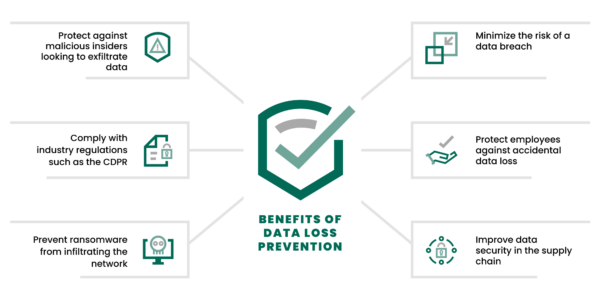Data Loss Prevention (DLP) refers to a set of strategies, tools, and processes designed to protect sensitive information from unauthorized access, disclosure, or theft. In an era where data breaches and cyber attacks are increasingly common, implementing effective DLP measures is essential for organizations to maintain the integrity, confidentiality, and availability of their data.
Understanding Data Loss Prevention
Data Loss Prevention involves the identification, classification, monitoring, and protection of sensitive data across networks, endpoints, and storage systems. By proactively detecting and preventing potential data breaches, DLP solutions help organizations comply with regulatory requirements, safeguard intellectual property, and mitigate financial and reputational risks.
Key Features of Data Loss Prevention
Effective DLP solutions typically include the following key features:
-
Content Discovery and Classification: Automatically identify and classify sensitive data based on predefined policies and rules, such as personally identifiable information (PII), financial records, or intellectual property.
-
Data Monitoring and Analysis: Continuously monitor data flows, user activities, and network traffic to detect suspicious behavior or policy violations in real-time.
-
Policy Enforcement and Remediation: Enforce data protection policies by blocking unauthorized access, encrypting sensitive data, or applying digital rights management (DRM) controls. Additionally, provide remediation actions to respond to incidents and mitigate risks.
-
User Education and Awareness: Educate employees about data security best practices, raise awareness about potential threats, and promote a culture of compliance within the organization.
Types of Data Loss Prevention
Data Loss Prevention solutions can be categorized based on their deployment models, enforcement methods, and scope of protection. Common types of DLP include:
| Type | Description |
|---|---|
| Network-based DLP | Monitors and controls data traffic at the network perimeter and within internal networks to prevent data leakage. |
| Endpoint DLP | Protects data on individual devices such as laptops, smartphones, and tablets through encryption, access controls, and data loss prevention agents. |
| Cloud DLP | Extends data protection capabilities to cloud-based applications and services, ensuring compliance with data privacy regulations in cloud environments. |
| Email and Web DLP | Scans email communications and web traffic for sensitive information and enforces data security policies to prevent unauthorized disclosure. |
Ways to Use Data Loss Prevention
Organizations can leverage Data Loss Prevention in various scenarios, including:
- Protecting sensitive customer data such as credit card numbers and social security numbers.
- Safeguarding confidential business documents, trade secrets, and intellectual property.
- Ensuring compliance with industry regulations and data protection laws, such as GDPR, HIPAA, and PCI DSS.
- Preventing accidental data leakage caused by human error, misconfiguration, or insider threats.
Challenges and Solutions
Despite its benefits, implementing Data Loss Prevention can present challenges such as:
- Balancing security and productivity concerns, particularly in environments where employees require access to sensitive data for legitimate business purposes.
- Overcoming resistance to change and ensuring user adoption of DLP policies and procedures.
- Addressing false positives and false negatives in DLP alerts, which can undermine the effectiveness of security controls.
To overcome these challenges, organizations should:
- Develop comprehensive DLP strategies tailored to their specific business requirements and risk profiles.
- Provide ongoing training and support to employees to promote awareness of data security risks and compliance obligations.
- Regularly evaluate and update DLP policies and technologies to adapt to evolving threats and regulatory requirements.
Characteristics and Comparisons
| Characteristic | Data Loss Prevention (DLP) | Intrusion Detection and Prevention Systems (IDPS) |
|---|---|---|
| Objective | Prevent unauthorized access, disclosure, or theft of sensitive data | Detect and respond to malicious activities and security breaches |
| Focus | Protects data at rest, in transit, and in use | Monitors network traffic and system logs for signs of suspicious behavior |
| Enforcement | Enforces data protection policies through access controls, encryption, and monitoring | Analyzes network packets and signatures to identify and block intrusions |
| Scope | Covers a wide range of data types and formats across multiple endpoints and networks | Focuses primarily on network-based threats and vulnerabilities |
Future Perspectives and Technologies
The future of Data Loss Prevention is closely tied to advancements in artificial intelligence, machine learning, and automation. Emerging technologies such as behavioral analytics, anomaly detection, and predictive analytics will enable organizations to proactively identify and mitigate data security risks in real-time.
VPN and Data Loss Prevention
Virtual Private Networks (VPNs) play a complementary role in Data Loss Prevention by encrypting data traffic and establishing secure connections between remote users and corporate networks. By routing traffic through encrypted tunnels, VPNs help prevent unauthorized interception and eavesdropping, thus enhancing the confidentiality and integrity of sensitive information.
Resources for More Information
For further reading on Data Loss Prevention, consider exploring the following resources:
- Gartner’s Magic Quadrant for Enterprise Data Loss Prevention
- The National Institute of Standards and Technology (NIST) Special Publication 800-171: Protecting Controlled Unclassified Information in Nonfederal Systems and Organizations
- The International Association of Privacy Professionals (IAPP) Guide to Data Loss Prevention and Privacy Compliance
In conclusion, Data Loss Prevention is an essential component of modern cybersecurity strategies, helping organizations protect their most valuable asset: their data. By implementing robust DLP solutions and fostering a culture of security awareness, businesses can minimize the risk of data breaches and maintain trust with customers, partners, and stakeholders.


